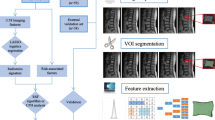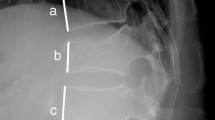Abstract
Background
Imminent new vertebral fracture (NVF) is highly prevalent after vertebral augmentation (VA). An accurate assessment of the imminent risk of NVF could help to develop prompt treatment strategies.
Purpose
To develop and validate predictive models that integrated the radiomic features and clinical risk factors based on machine learning algorithms to evaluate the imminent risk of NVF.
Materials and methods
In this retrospective study, a total of 168 patients with painful osteoporotic vertebral compression fractures treated with VA were evaluated. Radiomic features of L1 vertebrae based on lumbar T2-weighted images were obtained. Univariate and LASSO-regression analyses were applied to select the optimal features and construct radiomic signature. The radiomic signature and clinical signature were integrated to develop a predictive model by using machine learning algorithms including LR, RF, SVM, and XGBoost. Receiver operating characteristic curve and calibration curve analyses were used to evaluate the predictive performance of the models.
Results
The radiomic-XGBoost model with the highest AUC of 0.93 of the training cohort and 0.9 of the test cohort among the machine learning algorithms. The combined-XGBoost model with the best performance with an AUC of 0.9 in the training cohort and 0.9 in the test cohort. The radiomic-XGBoost model and combined-XGBoost model achieved better performance to assess the imminent risk of NVF than that of the clinical risk factors alone (p < 0.05).
Conclusion
Radiomic and machine learning modeling based on T2W images of preoperative lumbar MRI had an excellent ability to evaluate the imminent risk of NVF after VA.








Similar content being viewed by others
Abbreviations
- OVCF:
-
Osteoporotic vertebral compression fracture
- NVF:
-
New vertebral fracture
- VA:
-
Vertebral augmentation
- ROI:
-
Regions of interest
- ICC:
-
Intra-class correlation coefficients
- ROC:
-
Receiver operating characteristic
- AUC:
-
Area under the receiver operating characteristic curve
- LR:
-
Logistic regression
- RF:
-
Random forest
- SVM:
-
Support vector machine
- XGBoost:
-
Extreme gradient boosting
References
Compston JE, McClung MR, Leslie WD (2019) Osteoporos Lancet 393(10169):364–376
Johnell O, Kanis JA (2006) An estimate of the worldwide prevalence and disability associated with osteoporotic fractures. Osteoporos Int 17(12):1726–1733
Hopkins RB, Burke N, Von Keyserlingk C et al (2016) The current economic burden of illness of osteoporosis in Canada. Osteoporos Int 27(10):3023–1732
Burge R, Dawson-Hughes B, Solomon DH et al (2007) Incidence and economic burden of osteoporosis-related fractures in the United States, 2005–2025. J Bone Miner Res 22(3):465–475
Lin X, Xiong D, Peng YQ et al (2015) Epidemiology and management of osteoporosis in the People’s Republic of China: current perspectives. Clin Interv Aging 10:1017–1033
Yang EZ, Xu JG, Huang GZ et al (2016) Percutaneous vertebroplasty versus conservative treatment in aged patients with acute osteoporotic vertebral compression fractures: a prospective randomized controlled clinical study. Spine 41(8):653–660
Hoshino M, Takahashi S, Yasuda H et al (2019) Balloon kyphoplasty versus conservative treatment for acute osteoporotic vertebral fractures with poor prognostic factors: propensity score matched analysis using data from two prospective multicenter studies. Spine 44(2):110–117
Rho YJ, Choe WJ, Chun YI (2012) Risk factors predicting the new symptomatic vertebral compression fractures after percutaneous vertebroplasty or kyphoplasty. Eur Spine J 21(5):905–911
Lee BG, Choi JH, Kim DY et al (2019) Risk factors for newly developed osteoporotic vertebral compression fractures following treatment for osteoporotic vertebral compression fractures. Spine J 19(2):301–305
Roux C, Briot K (2017) Imminent fracture risk. Osteoporos Int 28(6):1765–1769
Johansson H, Siggeirsdóttir K, Harvey NC et al (2017) Imminent risk of fracture after fracture. Osteoporos Int 28(3):775–780
Park SM, Ahn SH, Kim HY et al (2020) Incidence and mortality of subsequent vertebral fractures: analysis of claims data of the Korea National Health Insurance Service from 2007 to 2016. Spine J 20(2):225–233
Bliuc D, Nguyen ND, Milch VE et al (2009) Mortality risk associated with low-trauma osteoporotic fracture and subsequent fracture in men and women. JAMA 301(5):513–521
Scapicchio C, Gabelloni M, Barucci A et al (2021) A deep look into radiomics. Radiol Med 126(10):1296–1311
Muehlematter UJ, Mannil M, Becker AS et al (2019) Vertebral body insufficiency fractures: detection of vertebrae at risk on standard CT images using texture analysis and machine learning. Eur Radiol 29(5):2207–2217
Burian E, Subburaj K, Mookiah M et al (2019) Texture analysis of vertebral bone marrow using chemical shift encoding-based water-fat MRI: a feasibility study. Osteoporos Int 30(6):1265–1274
Jiang YW, Xu XJ, Wang R et al (2022) Radiomics analysis based on lumbar spine CT to detect osteoporosis. Eur Radiol 32(11):8019–8026
Rastegar S, Vaziri M, Qasempour Y et al (2020) Radiomics for classification of bone mineral loss: a machine learning study. Diagn Interv Imaging 101(9):599–610
He L, Liu Z, Liu C et al (2021) Radiomics based on lumbar spine magnetic resonance imaging to detect osteoporosis. Acad Radiol 28(6):e165–e171
Zaworski C, Cheah J, Koff MF et al (2021) MRI-based texture analysis of trabecular bone for opportunistic screening of skeletal fragility. J Clin Endocrinol Metab 106(8):2233–2241
Grigoryan M, Guermazi A, Roemer FW et al (2003) Recognizing and reporting osteoporotic vertebral fractures. Eur Spine J 12(Suppl 2):S104–S112
Nieuwenhuijse MJ, van Rijswijk CS, van Erkel AR et al (2012) The intravertebral cleft in painful long-standing osteoporotic vertebral compression fractures treated with percutaneous vertebroplasty: diagnostic assessment and clinical significance. Spine 37(11):974–981
Garfin SR, Yuan HA, Reiley MA (2001) New technologies in spine: kyphoplasty and vertebroplasty for the treatment of painful osteoporotic compression fractures. Spine 26(14):1511–1515
Toth E, Banefelt J, Åkesson K et al (2020) History of previous fracture and imminent fracture risk in Swedish women aged 55 to 90 years presenting with a fragility fracture. J Bone Miner Res 35(5):861–868
LeBoff MS, Greenspan SL, Insogna KL et al (2022) The clinician’s guide to prevention and treatment of osteoporosis. Osteoporos Int 33(10):2049–2102
Zhong BY, He SC, Zhu HD et al (2017) Risk prediction of new adjacent vertebral fractures after PVP for patients with vertebral compression fractures: development of a prediction model. Cardiovasc Interv Radiol 40(2):277–284
Söreskog E, Ström O, Spångéus A et al (2020) Risk of major osteoporotic fracture after first, second and third fracture in Swedish women aged 50 years and older. Bone 134:115286
Li Q, Long X, Wang Y et al (2021) Development and validation of a nomogram for predicting the probability of new vertebral compression fractures after vertebral augmentation of osteoporotic vertebral compression fractures. BMC Musculoskelet Disord 22(1):957
Xue Z, Huo J, Sun X et al (2022) Using radiomic features of lumbar spine CT images to differentiate osteoporosis from normal bone density. BMC Musculoskelet Disord 23(1):336
Sollmann N, Becherucci EA, Boehm C et al (2022) Texture analysis using CT and chemical shift encoding-based water-fat MRI Can improve differentiation between patients with and without osteoporotic vertebral fractures. Front Endocrinol 1:778537
Perrier-Cornet J, Omorou AY, Fauny M et al (2019) Opportunistic screening for osteoporosis using thoraco–abdomino–pelvic CT-scan assessing the vertebral density in rheumatoid arthritis patients. Osteoporos Int 30(6):1215–1222
Jang S, Graffy PM, Ziemlewicz TJ et al (2019) Opportunistic osteoporosis screening at routine abdominal and thoracic CT: normative L1 trabecular attenuation values in more than 20000 adults. Radiology 291(2):360–367
Lee SJ, Graffy PM, Zea RD et al (2018) Future osteoporotic fracture risk related to lumbar vertebral trabecular attenuation measured at routine body CT. J Bone Miner Res 33(5):860–867
Gerety EL, Hopper MA, Bearcroft PW (2017) The reliability of measuring the density of the L1 vertebral body on CT imaging as a predictor of bone mineral density. Clin Radiol 72(2):177.e9-177.e15
Salzmann SN, Shirahata T, Yang J et al (2019) Regional bone mineral density differences measured by quantitative computed tomography: does the standard clinically used L1–L2 average correlate with the entire lumbosacral spine. Spine J 19(4):695–702
Dieckmeyer M, Junker D, Ruschke S et al (2020) Vertebral bone marrow heterogeneity using texture analysis of chemical shift encoding-based mri: variations in age, sex, and anatomical location. Front Endocrinol 11:555931
Maciel JG, Araújo IM, Trazzi LC et al (2020) Association of bone mineral density with bone texture attributes extracted using routine magnetic resonance imaging. Clinics 75:e1766
Geusens P, Bours S, Wyers CE et al (2019) Fracture liaison programs. Best Pract Res Clin Rheumatol 33(2):278–289
Funding
This project is provided by Guangzhou Science, Technology and Innovation Commission (Grand No. 202002030209), Guangzhou Municipal Health and Family Planning Commission (Grand No. 20201A010090).
Author information
Authors and Affiliations
Contributions
JC, CS and TY contributed equally as co-first authors because they are the guarantors of this work and take responsibility for the integrity of the data and the accuracy of the data analysis. ZL and QL contributed equally as co-corresponding authors because they designed this study and take responsibility for the integrity and reliability of the entire study and revised the manuscript.
Corresponding authors
Ethics declarations
Conflict of interest
No conflict of interest.
Additional information
Publisher's Note
Springer Nature remains neutral with regard to jurisdictional claims in published maps and institutional affiliations.
Rights and permissions
Springer Nature or its licensor (e.g. a society or other partner) holds exclusive rights to this article under a publishing agreement with the author(s) or other rightsholder(s); author self-archiving of the accepted manuscript version of this article is solely governed by the terms of such publishing agreement and applicable law.
About this article
Cite this article
Cai, J., Shen, C., Yang, T. et al. MRI-based radiomics assessment of the imminent new vertebral fracture after vertebral augmentation. Eur Spine J 32, 3892–3905 (2023). https://doi.org/10.1007/s00586-023-07887-y
Received:
Revised:
Accepted:
Published:
Issue Date:
DOI: https://doi.org/10.1007/s00586-023-07887-y




